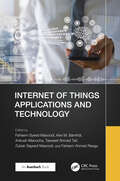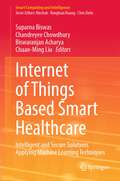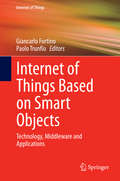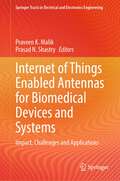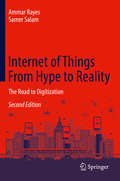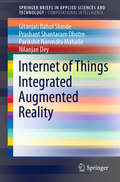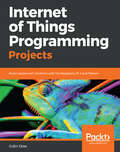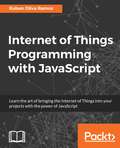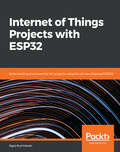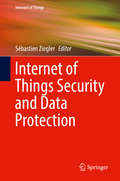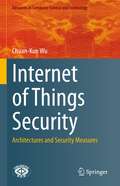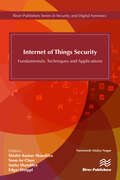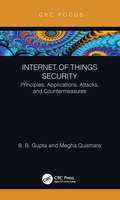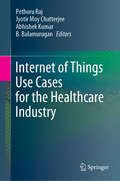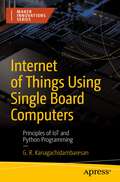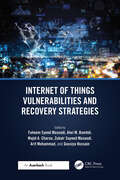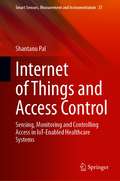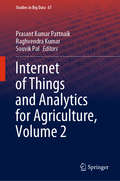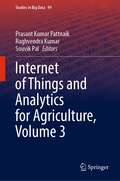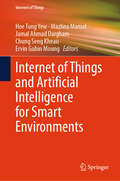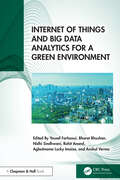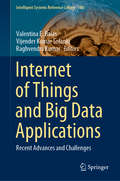- Table View
- List View
Internet of Things Applications and Technology
by Faheem Syeed Masoodi Zubair Sayeed Masoodi Alwi M. Bamhdi Ankush Manocha Tawseef Ahmed Teli Faheem Ahmad ReeguThe book provides a comprehensive examination of the integration of IoT technology into various industries and its impact on daily life, with a focus on the most recent advancements in the field. The technical aspects of IoT are thoroughly discussed, including the implementation of cutting-edge sensors, data communication protocols, and network topologies. The book also covers the latest advancements in areas such as edge computing, 5G networks, and AI-powered IoT devices. Emphasis is placed on the examination of IoT in real-world applications, including healthcare, agriculture, transportation, and home automation. Other highlights of the book include: IoT-based systems for monitoring air and water quality Wearable devices for continuous monitoring of vital signs and other health metrics IoT-based systems for monitoring and optimizing crop growth and yields Connected vehicles for improved safety, efficiency, and traffic management Monitoring of goods and resources in transit to optimize delivery times With case studies and real-world examples, readers gain a comprehensive understanding of how IoT is revolutionizing various industries and enhancing daily life. This book is a comprehensive guide to the exciting world of IoT and its practical application.
Internet of Things Based Smart Healthcare: Intelligent and Secure Solutions Applying Machine Learning Techniques (Smart Computing and Intelligence)
by Chuan-Ming Liu Biswaranjan Acharya Chandreyee Chowdhury Suparna BiswasThis book provides both the developers and the users with an awareness of the challenges and opportunities of advancements in healthcare paradigm with the application and availability of advanced hardware, software, tools, technique or algorithm development stemming the Internet of Things. The book helps readers to bridge the gap in their three understanding of three major domains and their interconnections: Hardware tested and software APP development for data collection, intelligent protocols for analysis and knowledge extraction. Medical expertise to interpret extracted knowledge towards disease prediction or diagnosis and support. Security experts to ensure data correctness for precise advice. The book provides state-of-the-art overviews by active researchers, technically elaborating healthcare architectures/frameworks, protocols, algorithms, methodologies followed by experimental results and evaluation. Future direction and scope will be precisely documented for interested readers.
Internet of Things Based on Smart Objects
by Giancarlo Fortino Paolo TrunfioThe Internet of Things (IoT) usually refers to a world-wide network of interconnected heterogeneous objects (sensors, actuators, smart devices, smart objects, RFID, embedded computers, etc) uniquely addressable, based on standard communication protocols. Beyond such a definition, it is emerging a new definition of IoT seen as a loosely coupled, decentralized system of cooperating smart objects (SOs). A SO is an autonomous, physical digital object augmented with sensing/actuating, processing, storing, and networking capabilities. SOs are able to sense/actuate, store, and interpret information created within themselves and around the neighbouring external world where they are situated, act on their own, cooperate with each other, and exchange information with other kinds of electronic devices and human users. However, such SO-oriented IoT raises many in-the-small and in-the-large issues involving SO programming, IoT system architecture/middleware and methods/methodologies for the development of SO-based applications. This Book will specifically focus on exploring recent advances in architectures, algorithms, and applications for an Internet of Things based on Smart Objects. Topics appropriate for this Book include, but are not necessarily limited to: - Methods for SO development - IoT Networking - Middleware for SOs - Data Management for SOs - Service-oriented SOs - Agent-oriented SOs - Applications of SOs in Smart Environments: Smart Cities, Smart Health, Smart Buildings, etc. Advanced IoT Projects.
Internet of Things Enabled Antennas for Biomedical Devices and Systems: Impact, Challenges and Applications (Springer Tracts in Electrical and Electronics Engineering)
by Prasad N. Shastry Praveen K. MalikThe book consists of the latest research in biomedical and communication integration. It discusses the fabrication and testing outcomes of the Internet of Things-enabled biomedical applications. The book focuses on recent advances in the field of planar antenna design and their applications in space communication, mobile communication, wireless communication, and wearable applications. Planar antennas are also used in medical applications in microwave imaging, medical implants, hyperthermia treatments, and wireless wellness monitoring. This book presents planar antenna design concepts, methods, and techniques to enhance the performance parameters and applications for IoT and device-to-device communication. It provides the latest techniques used for the design of antennas in terms of their structures, defected ground, MIMO, and fractal design. This book also addresses the specific steps to resolve issues in designing antennas and how to design conformal and miniaturized antenna structures for various applications.
Internet of Things From Hype to Reality: The Road to Digitization
by Ammar Rayes Samer SalamThis textbook presents an end-to-end Internet of Things (IoT) architecture that comprises of devices, network, compute, storage, platform, applications along with management and security components with focus on the missing functionality in the current state of the art. As with the first edition, it is organized into six main parts: an IoT reference model; Fog computing and the drivers; IoT management and applications ranging from smart homes to manufacturing and energy conservation solutions; Smart Services in IoT; IoT standards; and case studies. The textbook edition features a new chapter entitled The Blockchain in IoT, updates based on latest standards and technologies, and new slide ware for professors. It features a full suite of classroom material for easy adoption.
Internet of Things Integrated Augmented Reality (SpringerBriefs in Applied Sciences and Technology)
by Nilanjan Dey Gitanjali Rahul Shinde Prashant Shantaram Dhotre Parikshit Narendra MahalleThis book discusses the use of converged technology, a rapidly growing area that enhancements smart devices, communication, Internet of things (IoT), and augmented reality (AR). The book also explores the need for convergence of IoT and AR for various purposes, like personalized services, context awareness, and bridging the gap between the physical and digital world. Furthermore, it examines the implementation of IoT and AR in use cases to define pathways that allow application developers to design modern solutions to satisfy requirements like scalability, abstraction and security. Featuring an introduction, and covering sensing techniques, and effective architecture in AR-based IoT real-time use cases, the book also addresses the issues and challenges in designing standard architecture and middleware to support diverse applications. Given its scope, it is a valuable resource for teachers and students in engineering, as well as researchers, developers, and users working in multi-disciplinary areas.
Internet of Things Programming Projects: Build modern IoT solutions with the Raspberry Pi 3 and Python
by Colin DowA practical project-based guide to help you build and control your IoT projects Key Features Leverage the full potential of IoT with the combination of Raspberry Pi 3 and Python Build complex Python-based applications with IoT Work on various IoT projects and understand the basics of electronics Book Description The Internet of Things (IOT) has managed to attract the attention of researchers and tech enthusiasts, since it powerfully combines classical networks with instruments and devices. In Internet of Things Programming Projects, we unleash the power of Raspberry Pi and Python to create engaging projects. In the first part of the book, you'll be introduced to the Raspberry Pi, learn how to set it up, and then jump right into Python programming. Then, you'll dive into real-world computing by creating a“Hello World” app using flash LEDs. As you make your way through the chapters, you'll go back to an age when analog needle meters ruled the world of data display. You'll learn to retrieve weather data from a web service and display it on an analog needle meter, and build a home security system using the Raspberry Pi. The next project has a modern twist, where we employ the Raspberry Pi to send a signal to a web service that will send you a text when someone is at the door. In the final project, you take what you've learned from the previous two projects and create an IoT robot car that you can use to monitor what your pets are up to when you are away. By the end of this book, you will be well versed in almost every possible way to make your IoT projects stand out. What you will learn Install and set up a Raspberry Pi for IoT development Learn how to use a servo motor as an analog needle meter to read data Build a home security dashboard using an infrared motion detector Communicate with a web service that sends you a message when the doorbell rings Receive data and display it with an actuator connected to the Raspberry Pi Build an IoT robot car that is controlled through the internet Who this book is for Internet of Things Programming Projects is for Python developers and programmers who are interested in building their own IoT applications and IoT-based projects. It is also targeted at IoT programmers and developers who are looking to build exciting projects with Python.
Internet of Things Programming with JavaScript
by Ruben Oliva RamosLearn the art of bringing the Internet of Things into your projects with the power of JavaScript About This Book • This is a practical guide to help you configure and build a complete distributed IoT system from scratch using JavaScript • Utilize the power of Node and HTML5 to develop web services and a centralized web server, enabling high-level communication between connected devices • Control all your connected devices from the browser by setting up a common dashboard Who This Book Is For This book is for developers who are interested in learning how to communicate with connected devices in JavaScript to set up an IoT system. Some basic knowledge of JavaScript is expected. Hobbyists who want to explore the potential of IoT in JavaScript will also find this book useful. What You Will Learn • Develop the skills to connected devices prepared the field to interact with the devices in a network system Internet of Things • Find out how to connect sensors and actuators to the devices • Send data to a web server connected devices • Understand Internet of things using web services and database • Configure a dashboard using HTML5 and JavaScript • Control devices connected from a dashboard • Monitor different devices from the dashboard • Build an app for a smartphone to control different devices In Detail The Internet of Things (IoT) is an entirely new platform for developers and engineers, but one thing that remains consistent as we move into this new world, are the programming languages. JavaScript is the most widely used language over the Internet, and with IoT gaining momentum, you will learn how to harness the power of JavaScript to interact with connected devices. This book will teach you how to interact with endpoint devices by developing web services in JavaScript and also set up an interface to control all connected devices. This book begins with setting up a centralized web server that serves as a hub for all connected devices. The book then progresses further towards building web services to facilitate high-level communication between connected devices. Using Arduino and Raspberry Pi Zero as endpoint devices, the book will show you how devices can communicate with each other, perform a wide range of tasks, and also be controlled from a centralized location using JavaScript. The book ends with creating a hybrid app to control the devices that can be run from a browser or installed on a smartphone. Style and approach This book offers step-by-step guidance on how to set up a distributed IoT system using JavaScript. It will teach you how to interact with endpoint devices by developing web services in JavaScript and also set up an interface for controlling all connected devices.
Internet of Things Projects with ESP32: Build exciting and powerful IoT projects using the all-new Espressif ESP32
by Agus KurniawanCreate and program Internet of Things projects using the Espressif ESP32. Key Features Getting to know the all new powerful EPS32 boards and build interesting Internet of Things projects Configure your ESP32 to the cloud technologies and explore the networkable modules that will be utilised in your IoT projects A step-by-step guide that teaches you the basic to advanced IoT concepts with ESP32 Book Description ESP32 is a low-cost MCU with integrated Wi-Fi and BLE. Various modules and development boards-based on ESP32 are available for building IoT applications easily. Wi-Fi and BLE are a common network stack in the Internet of Things application. These network modules can leverage your business and projects needs for cost-effective benefits. This book will serve as a fundamental guide for developing an ESP32 program. We will start with GPIO programming involving some sensor devices. Then we will study ESP32 development by building a number of IoT projects, such as weather stations, sensor loggers, smart homes, Wi-Fi cams and Wi-Fi wardriving. Lastly, we will enable ESP32 boards to execute interactions with mobile applications and cloud servers such as AWS. By the end of this book, you will be up and running with various IoT project-based ESP32 chip. What you will learn Understand how to build a sensor monitoring logger Create a weather station to sense temperature and humidity using ESP32 Build your own W-iFi wardriving with ESP32. Use BLE to make interactions between ESP32 and Android Understand how to create connections to interact between ESP32 and mobile applications Learn how to interact between ESP32 boards and cloud servers Build an IoT Application-based ESP32 board Who this book is for This book is for those who want to build a powerful and inexpensive IoT projects using the ESP32.Also for those who are new to IoT, or those who already have experience with other platforms such as Arduino, ESP8266, and Raspberry Pi.
Internet of Things Projects with ESP32: Build exciting and powerful IoT projects using the all-new Espressif ESP32
by Agus KurniawanCreate and program Internet of Things projects using the Espressif ESP32. Key FeaturesGetting to know the all new powerful EPS32 boards and build interesting Internet of Things projectsConfigure your ESP32 to the cloud technologies and explore the networkable modules that will be utilised in your IoT projectsA step-by-step guide that teaches you the basic to advanced IoT concepts with ESP32 Book DescriptionESP32 is a low-cost MCU with integrated Wi-Fi and BLE. Various modules and development boards-based on ESP32 are available for building IoT applications easily. Wi-Fi and BLE are a common network stack in the Internet of Things application. These network modules can leverage your business and projects needs for cost-effective benefits. This book will serve as a fundamental guide for developing an ESP32 program. We will start with GPIO programming involving some sensor devices. Then we will study ESP32 development by building a number of IoT projects, such as weather stations, sensor loggers, smart homes, Wi-Fi cams and Wi-Fi wardriving. Lastly, we will enable ESP32 boards to execute interactions with mobile applications and cloud servers such as AWS. By the end of this book, you will be up and running with various IoT project-based ESP32 chip. What you will learnUnderstand how to build a sensor monitoring loggerCreate a weather station to sense temperature and humidity using ESP32Build your own W-iFi wardriving with ESP32. Use BLE to make interactions between ESP32 and AndroidUnderstand how to create connections to interact between ESP32 and mobile applicationsLearn how to interact between ESP32 boards and cloud serversBuild an IoT Application-based ESP32 boardWho this book is forThis book is for those who want to build a powerful and inexpensive IoT projects using the ESP32.Also for those who are new to IoT, or those who already have experience with other platforms such as Arduino, ESP8266, and Raspberry Pi.
Internet of Things Security and Data Protection (Internet of Things)
by Sébastien ZieglerThis book provides an overview of the most recent developments in Internet of Things (IoT) security and data protection. It presents the results of several international research projects addressing this topic from complementary angles. It starts by analyzing the main privacy and security threats on IoT, as well as the evolution of data protection norms, such as the European General Data Protection Regulation (GDPR), and their impact on IoT. Through a comprehensive and systematic approach, the contributors present new perspectives on IoT & Cloud Computing security requirements. They discuss the most recent approach to support trusted IoT, including new models of privacy risk assessment, labeling and certification, and contractual tools (such as Privacy PACT). Practical implementations, such as in the European Large Scale Pilots on IoT for Smart Cities (Synchronicity), are presented, explaining how they address security, privacy and data protection. Finally, innovative models to secure IoT systems are presented for the network and end-nodes security, including network threats analysis.
Internet of Things Security: Architectures and Security Measures (Advances in Computer Science and Technology)
by Chuan-Kun WuThis book presents a systematic and comprehensive overview for IoT security. It first introduces architecture approaches for IoT and IoT security, describing the security techniques for different layers in the IoT security architecture. It also provides an in-depth analysis on the difference between IoT security and traditional system and data security. It is commonly known that information security includes data confidentiality, data integrity, and availability, and that measures include non-repudiation and access control. However, in practical IoT system construction, many more security measures need to be carefully considered. As such, this book presents around 60 different security measures, mainly focusing on the sensor layer of IoT. These security measures can serve as a source of reference for IoT system construction, as well as IoT security standard making.
Internet of Things Security: Challenges, Advances, and Analytics
by Chintan Patel Nishant DoshiMost of the devices in the Internet of Things will be battery powered sensor devices. All the operations done on battery powered devices require minimum computation. Secure algorithms like RSA become useless in the Internet of Things environment. Elliptic curve based cryptography emerges as a best solution for this problem because it provides higher security in smaller key size compare to RSA. This book focuses on the use of Elliptic Curve Cryptography with different authentication architectures and authentication schemes using various security algorithms. It also includes a review of the math required for security and understanding Elliptic Curve Cryptography.
Internet of Things Security: Fundamentals, Techniques and Applications
by Edgar Weippl Shishir Kumar Shandilya Smita Shandilya Soon Ae ChunInternet of Things (IoT) security deals with safeguarding the devices and communications of IoT systems, by implementing protective measures and avoiding procedures which can lead to intrusions and attacks. However, security was never the prime focus during the development of the IoT, hence vendors have sold IoT solutions without thorough preventive measures. The idea of incorporating networking appliances in IoT systems is relatively new, and hence IoT security has not always been considered in the product design. To improve security, an IoT device that needs to be directly accessible over the Internet should be segmented into its own network, and have general network access restricted. The network segment should be monitored to identify potential anomalous traffic, and action should be taken if a problem arises. This has generated an altogether new area of research, which seeks possible solutions for securing the devices, and communication amongst them.
Internet of Things Security: Principles and Practice
by Qinghao Tang Fan DuOver the past few years, Internet of Things has brought great changes to the world. Reports show that, the number of IoT devices is expected to reach 10 billion units within the next three years. The number will continue to rise and wildly use as infrastructure and housewares with each passing day, Therefore, ensuring the safe and stable operation of IoT devices has become more important for IoT manufacturers. Generally, four key aspects are involved in security risks when users use typical IoT products such as routers, smart speakers, and in-car entertainment systems, which are cloud, terminal, mobile device applications, and communication data. Security issues concerning any of the four may lead to the leakage of user sensitive data. Another problem is that most IoT devices are upgraded less frequently, which leads it is difficult to resolve legacy security risks in short term. In order to cope with such complex security risks,Security Companies in China, such as Qihoo 360, Xiaomi, Alibaba and Tencent, and companies in United States, e.g. Amazon, Google, Microsoft and some other companies have invested in security teams to conduct research and analyses, the findings they shared let the public become more aware of IoT device security-related risks. Currently, many IoT product suppliers have begun hiring equipment evaluation services and purchasing security protection products. As a direct participant in the IoT ecological security research project, I would like to introduce the book to anyone who is a beginner that is willing to start the IoT journey, practitioners in the IoT ecosystem, and practitioners in the security industry. This book provides beginners with key theories and methods for IoT device penetration testing; explains various tools and techniques for hardware, firmware and wireless protocol analysis; and explains how to design a secure IoT device system, while providing relevant code details.
Internet of Things Security: Principles, Applications, Attacks, and Countermeasures
by Brij B. Gupta Megha QuamaraThe Internet of Things (IoT), with its technological advancements and massive innovations, is building the idea of inter-connectivity among everyday life objects. With an explosive growth in the number of Internet-connected devices, the implications of the idea of IoT on enterprises, individuals, and society are huge. IoT is getting attention from both academia and industry due to its powerful real-time applications that raise demands to understand the entire spectrum of the field. However, due to increasing security issues, safeguarding the IoT ecosystem has become an important concern. With devices and information becoming more exposed and leading to increased attack possibilities, adequate security measures are required to leverage the benefits of this emerging concept. Internet of Things Security: Principles, Applications, Attacks, and Countermeasures is an extensive source that aims at establishing an understanding of the core concepts of IoT among its readers and the challenges and corresponding countermeasures in the field. Key features: Containment of theoretical aspects, as well as recent empirical findings associated with the underlying technologies Exploration of various challenges and trade-offs associated with the field and approaches to ensure security, privacy, safety, and trust across its key elements Vision of exciting areas for future research in the field to enhance the overall productivity This book is suitable for industrial professionals and practitioners, researchers, faculty members, and students across universities who aim to carry out research and development in the field of IoT security.
Internet of Things Use Cases for the Healthcare Industry
by Pethuru Raj Abhishek Kumar Jyotir Moy Chatterjee B. BalamuruganThis book explores potentially disruptive and transformative healthcare-specific use cases made possible by the latest developments in Internet of Things (IoT) technology and Cyber-Physical Systems (CPS). Healthcare data can be subjected to a range of different investigations in order to extract highly useful and usable intelligence for the automation of traditionally manual tasks. In addition, next-generation healthcare applications can be enhanced by integrating the latest knowledge discovery and dissemination tools. These sophisticated, smart healthcare applications are possible thanks to a growing ecosystem of healthcare sensors and actuators, new ad hoc and application-specific sensor and actuator networks, and advances in data capture, processing, storage, and mining. Such applications also take advantage of state-of-the-art machine and deep learning algorithms, major strides in artificial and ambient intelligence, and rapid improvements in the stability and maturity of mobile, social, and edge computing models.
Internet of Things Using Single Board Computers: Principles of IoT and Python Programming (Maker Innovations Ser.)
by G. R. KanagachidambaresanRapidly prototype and program new IoT and Edge solutions using low-cost Maker tech, such as those from Arduino, Raspberry Pi and Nvidia. With a focus on the electronics, this book allows experienced computer science students as well as researchers, practitioners, and even hobbyists to dive right into actual engineering of prototypes and not just theoretical programming and algorithms. You'll learn to interface sensors, work with various communication mediums, incorporate wired and wireless communication protocols, and more with these single board computers. All while working in the popular Python programming language. Additionally, you’ll discover both scripting-based and drag and drop solutions for different problems. As well as a variety of useful, data gathering approaches. Then you can apply what you’ve learned to IoT projects and troubleshooting Industry 4.0 problems. The rapid growth of technology and new development initiatives has made the Internet of Things and Edge analytics an inevitable platform in all engineering domains. The need for sophisticated and ambient environments controlled by tech has resulted in an exponential growth of automation and artificial intelligence. Internet of Things Using Single Board Computers reflects these recent developments while providing a low-cost, easy ramp into the fields of IoT using single board computers and Python programming. What You'll LearnProgram Arduino, Raspberry Pi, and Nvidia boards for rapid prototyping in IoT and Edge environmentsInterface sensors, communication mediums, and wired and wireless communications into your programs and projects.Study practical applications of these low-cost solutions in fields such as home automation, smart cities, electrical vehicle charging, and more.Who This Book is ForEngineers and hobbyists working on Internet of Things prototypes and applications. Basic skills in electronics and a working knowledge of Python are recommended. Engineers and scientists working on smart environment projects and smart city applications will also benefit.
Internet of Things Vulnerabilities and Recovery Strategies
by Faheem Syeed Masoodi Alwi M Bamhdi Majid A Charoo Zubair Sayeed MasoodiThe Internet of Things (IoT) is a widely distributed and networked system of interrelated and interacting computing devices and objects. Because of IoT’s broad scope, it presents unique security problems, ranging from unsecure devices to users vulnerable to hackers. Presenting cutting- edge research to meet these challenges, Internet of Things Vulnerabilities and Recovery Strategies presents models of attack on IoT systems and solutions to prevent such attacks. Examining the requirements to secure IoT- systems, the book offers recovery strategies and addresses security concerns related to: Data Routing Data Integrity Device Supervision IoT Integration Information Storage IoT Performance The book takes a holistic approach that encompasses visibility, segmentation, and protection. In addition to visual approaches and policy- driven measures, the book looks at developing secure and fault- tolerant IoT devices. It examines how to locate faults and presents mitigation strategies, as well as security models to prevent and thwart hacking. The book also examines security issues related to IoT systems and device maintenance.
Internet of Things and Access Control: Sensing, Monitoring and Controlling Access in IoT-Enabled Healthcare Systems (Smart Sensors, Measurement and Instrumentation #37)
by Shantanu PalThis book presents the design and development of an access control architecture for the Internet of Things (IoT) systems. It considers the significant authentication and authorization issues for large-scale IoT systems, in particular, the need for access control, identity management, delegation of access rights and the provision of trust within such systems. It introduces a policy-based access control approach for the IoT that provides fine-grained access for authorized users to services while protecting valuable resources from unauthorized access. Further, the book discusses an identity-less, asynchronous and decentralized delegation model for the IoT leveraging the advantage of blockchain technology. It also presents an approach of attribute-based identity and examines the notion of trust in an IoT context by considering the uncertainty that exists in such systems. Fully explaining all the techniques used, the book is of interest to engineers, researchers and scientists working in the field of the wireless sensor networks, IoT systems and their access control management.
Internet of Things and Analytics for Agriculture, Volume 2 (Studies in Big Data #67)
by Prasant Kumar Pattnaik Raghvendra Kumar Souvik PalThis book addresses major challenges faced by farmers and the technological solutions based on Internet of Things (IoT). A major challenge in agriculture is cultivating and supplying high-quality produce at the best. Currently, around 50% of global farm produce never reaches the end consumer due to wastage and suboptimal prices. The book presents solutions that reduce the transport costs, improve the predictability of prices based on data analytics and the current market conditions, and reduce the number of middle steps and agents between the farmer and the end consumer. It discusses the design of an IoT-based monitoring system to analyze crop environments and a method to improve the efficiency of decision-making by analyzing harvest statistics. Further, it explores climate-smart methods, known as smart agriculture, that have been adopted by a number of Indian farmers.
Internet of Things and Analytics for Agriculture, Volume 3 (Studies in Big Data #99)
by Prasant Kumar Pattnaik Raghvendra Kumar Souvik PalThe book discusses one of the major challenges in agriculture which is delivery of cultivate produce to the end consumers with best possible price and quality. Currently all over the world, it is found that around 50% of the farm produce never reaches the end consumer due to wastage and suboptimal prices. The authors present solutions to reduce the transport cost, predictability of prices on the past data analytics and the current market conditions, and number of middle hops and agents between the farmer and the end consumer using IoT-based solutions. Again, the demand by consumption of agricultural products could be predicted quantitatively; however, the variation of harvest and production by the change of farm's cultivated area, weather change, disease and insect damage, etc., could be difficult to be predicted, so that the supply and demand of agricultural products has not been controlled properly. To overcome, this edited book designed the IoT-based monitoring system to analyze crop environment and the method to improve the efficiency of decision making by analyzing harvest statistics. The book is also useful for academicians working in the areas of climate changes.
Internet of Things and Artificial Intelligence for Smart Environments (Internet of Things)
by Hoe Tung Yew Mazlina Mamat Jamal Ahmad Dargham Chung Seng Kheau Ervin Gubin MoungThis book highlights the application of smart technologies that utilize the Internet of Things (IoT) and Artificial Intelligence (AI) to enhance efficiency and productivity across various industries. It provides a comprehensive review of the latest IoT and AI developments, including their applications, opportunities, and challenges in smart environments. This book is a valuable resource for researchers, engineers, academics, and students working on implementing smart technologies.
Internet of Things and Big Data Analytics for a Green Environment
by Bharat Bhushan Anshul Verma Yousef Farhaoui Agbotiname Lucky Imoize Nidhi Sindhwani Rohit AnandThis book studies the evolution of sustainable green smart cities and demonstrates solutions for green environmental issues using modern industrial IoT solutions. It is a ready reference with guidelines and a conceptual framework for context-aware product development and research in the IoT paradigm and Big Data Analytics for a Green Environment. It brings together the most recent advances in IoT and Big Data in Green Environments, emerging aspects of the IoT and Big Data for Green Cities, explores key technologies, and develops new applications in this research field.Key Features:• Discusses the framework for development and research in the IoT Paradigm and Big Data Analytics.• Highlights threats to the IoT architecture and Big Data Analytics for a Green Environment. • Present the I-IoT architecture, I-IoT applications, and their characteristics for a Green Environment. • Provides a systematic overview of the state-of-the-art research efforts.• Introduces necessary components and knowledge to become a vital part of the IoT revolution for a Green Environment.This book is for professionals and researchers interested in the emerging technology of sustainable development, green cities, and Green Environment.
Internet of Things and Big Data Applications: Recent Advances and Challenges (Intelligent Systems Reference Library #180)
by Raghvendra Kumar Valentina E. Balas Vijender Kumar SolankiThis book provides essential future directions for IoT and Big Data research. Thanks to rapid advances in sensors and wireless technology, Internet of Things (IoT)-related applications are attracting more and more attention. As more devices are connected, they become potential components for smart applications. Thus, there is a new global interest in these applications in various domains such as health, agriculture, energy, security and retail. The main objective of this book is to reflect the multifaceted nature of IoT and Big Data in a single source. Accordingly, each chapter addresses a specific domain that is now being significantly impacted by the spread of soft computing
